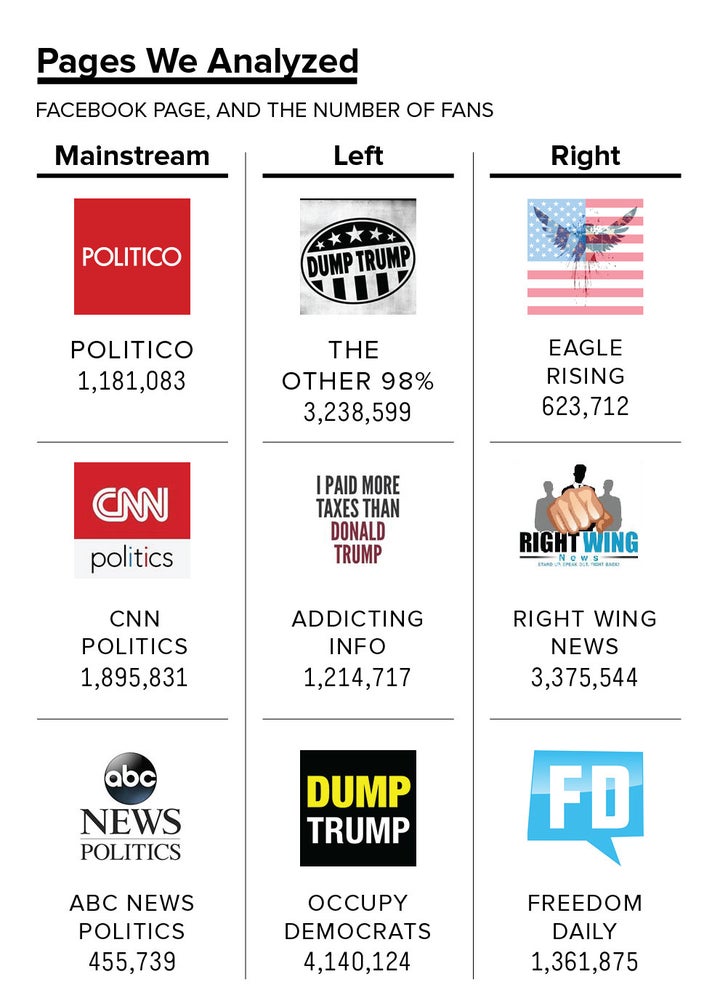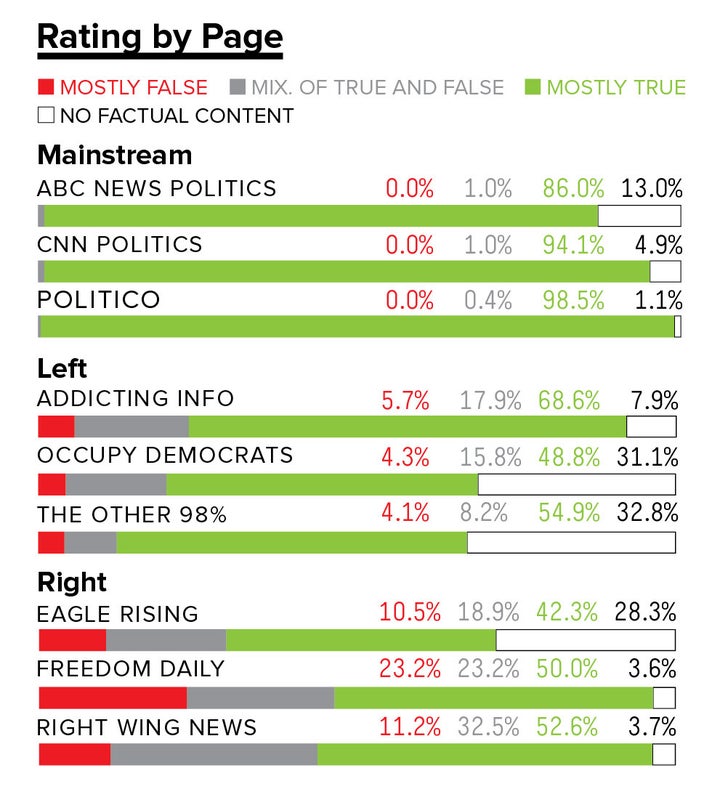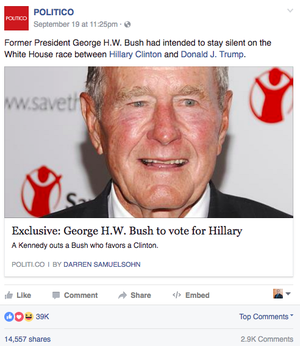
Mark Davis / BuzzFeed News
Hyperpartisan political Facebook pages and websites are consistently feeding their millions of followers false or misleading information, according to an analysis by BuzzFeed News. The review of more than 1,000 posts from six large hyperpartisan Facebook pages selected from the right and from the left also found that the least accurate pages generated some of the highest numbers of shares, reactions, and comments on Facebook — far more than the three large mainstream political news pages analyzed for comparison.
Our analysis of three hyperpartisan right-wing Facebook pages found that 38% of all posts were either a mixture of true and false or mostly false, compared to 19% of posts from three hyperpartisan left-wing pages that were either a mixture of true and false or mostly false. The right-wing pages are among the forces — perhaps as potent as the cable news shows that have gotten far more attention — that helped fuel the rise of Donald Trump.
These pages, with names such as Eagle Rising on the right and Occupy Democrats on the left, represent a new and powerful force in American politics and society. Many have quickly grown to be as large as — and often much larger than — mainstream political news pages. A recent feature in the New York Times Magazine reported on the growth and influence of these pages, saying they “have begun to create and refine a new approach to political news: cherry-picking and reconstituting the most effective tactics and tropes from activism, advocacy and journalism into a potent new mixture.”
The rapid growth of these pages combines with BuzzFeed News' findings to suggest a troubling conclusion: The best way to attract and grow an audience for political content on the world&039;s biggest social network is to eschew factual reporting and instead play to partisan biases using false or misleading information that simply tells people what they want to hear. This approach has precursors in partisan print and television media, but has gained a new scale of distribution on Facebook. And while it isn&039;t a solely American phenomenon — the British Labour party found powerful support from a similar voice — these pages are central to understanding a profoundly polarized moment in American life.
For example, in late September, Freedom Daily, a Facebook page with more than 1 million fans, scored a viral hit with a post that filled its audience with racial outrage.
The post linked to an article on the Freedom Daily website with the headline “Two White Men Doused With Gasoline, Set On FIRE By Blacks – Media CENSORED (VIDEO).” The text that accompanied the link on Facebook connected the attack to recent Black Lives Matter protests and urged people to share the post “if you&039;re angry as hell & aren&039;t going to take it anymore!”

Freedom Daily / Facebook / Via Facebook: FreedomDailyNews
Anyone clicking on the link saw a video of the altercation, with some additional commentary. “Back in the day, when people were a lot smarter and America was great, this would have been a lot different,” the article said.
But nowhere in the article or Facebook post did Freedom Daily make it clear that this incident happened almost a year ago, and that it had absolutely no connection to Black Lives Matter.
The falsehoods continued from there: The altercation was actually between two people, a black man and his co-worker — and perhaps most importantly, the co-worker is not white. Court documents allege that the fight began with the co-worker throwing the first punch. Prosecutors also said the second man caught fire as a result of him coming into contact with the first man who was engulfed in flames. And finally, in spite of the headline&039;s claim that the incident was “CENSORED” by the media, it was widely covered by Baltimore media as well as by CNN and the Daily Mail&039;s website. (The man who allegedly set the fire, Christopher Harrison Jr., was charged with attempted first-degree murder, reckless endangerment, and first- and second-degree assault.)
But these details only stood in the way of success on Facebook. In the end, Freedom Daily&039;s largely false post was shared more than 14,000 times, generating more than 9,000 reactions and over 2,000 angry comments on Facebook.
“Not even animals would do this,” reads the most liked comment on the post. “Time to hang these people.”
Pages like Freedom Daily play to the biases of their audiences — and to those of Facebook&039;s News Feed algorithm — by sharing videos, photos, and links that demonize opposing points of view. They write explosive headlines and passages that urge people to click and share in order to show their support, or to express outrage. And in this tense and polarizing presidential election season, they continue to grow and gain influence.
“They are, perhaps, the purest expression of Facebook’s design and of the incentives coded into its algorithm,” wrote John Herrman in the New York Times Magazine.
These pages are also a constant source of dubious, misleading, or completely false information.
During the period analyzed, right-wing pages, for example, pushed a conspiracy theory about a Hillary Clinton body double, recirculated an old and false story about a Canadian mayor lecturing Muslim immigrants about integration, wrongly claimed that Obama&039;s last address at the UN saw him tell Americans they needed to give up their freedom for a “New World Government,” and falsely claimed that a football player had been told not to pray by the NFL.
Left-wing pages wrongly claimed Putin&039;s online troll factory was responsible for rigging online polls to show Trump won the first debate, falsely said that Trump wants to expel all Muslims from the US and said US women in the military should expect to be raped, claimed that TV networks would “not be fact-checking Donald Trump in any way” at the first debate, and completely misrepresented a quote from the pope to claim that he “flat out called Fox News type journalism &039;terrorism.&039;”
The bottom line is that people who regularly consume information from these pages — especially those on the right — are being fed false or misleading information.
The nature of the falsehoods is important to note. They often take the form of claims and accusations against people, companies, police, movements such as Black Lives Matter, Muslims, or “liberals” or “conservatives” as a whole. They drive division and polarization. And in doing so, they generate massive Facebook engagement that brings more and more people to these pages and their websites and into the echo chamber of hyperpartisan media and beliefs.
What We Did
BuzzFeed News selected three large hyperpartisan Facebook pages each from the right and from the left, as well as three large mainstream political news pages. All nine pages have earned the coveted verified blue checkmark from Facebook, which gives them an additional layer of credibility on the platform.

The nine pages we analyzed. Fan numbers shown for each page are as of Oct. 17, 2016.
BuzzFeed News
Over the course of seven weekdays (Sept. 19 to 23 and Sept. 26 and 27), we logged and fact-checked every single post published by these pages. Posts could be rated “mostly true,” “mixture of true and false,” or “mostly false.” If we encountered a post that was satirical or opinion-driven, or that otherwise lacked a factual claim, we rated it “no factual content.” (We chose to rate things as “mostly” true or false in order to allow for smaller errors or accurate facts within otherwise true or false claims or stories.)
We also gathered additional data: Facebook engagement numbers (shares, comments, and reactions) for each post were added from the Facebook API, and we noted whether the post was a link, photo, video, or text. Raters were asked to provide notes and sources to explain their rulings of “mixture of true and false” or “mostly false.” They could also indicate whether they were unsure of a given rating, which would trigger a second review of the same post in order to ensure consistency. Any discrepancies between the two ratings were resolved by a third person. That same person conducted a final review of all posts that were rated mostly false to ensure they warranted that rating. (For more detail on the methodology and some notes on its limitations, see the bottom of this article, and you can view our data here.)
In the end, our team rated and gathered data on 2,282 posts. There were 1,145 posts from mainstream pages, 666 from hyperpartisan right-wing pages, and 471 from hyperpartisan left-wing pages. The difference in the number of posts for each group is a result of them publishing with different frequencies.
Accuracy: Right vs. Left

BuzzFeed News
All nine pages consisted largely of content that was either mostly true or earned a “no factual content” rating.
However, during the time period analyzed, we found that right-wing pages were more prone to sharing false or misleading information than left-wing pages. Mainstream pages did not share any completely false information, but did publish a small number of posts that included unverified claims. (More on that below.)
We rated 86 out of a total 666 right-wing Facebook posts as mostly false, for a percentage of 13%. Another 167 posts (25%) were rated as a mixture of true and false. Viewed separately or together (38%), this is an alarmingly high percentage.
Left-wing pages did not earn as many “mostly false” or “mixture of true and false” ratings, but they did share false and misleading content. We identified 22 mostly false posts out of a total of 471 from these pages, which means that just under 5% of left-wing posts were untrue. We rated close to 14% of these posts (68) a mixture of true and false. Taken together, nearly a fifth of all left-wing posts we analyzed were either partially or mostly false.
One of the most common reasons we rated a post as a mixture of true and false was because the headline and/or Facebook share line introduced misinformation or was misleading to the audience. This frequently took the form of a shared link that contained accurate body text paired with a misleading headline, likely to drive social engagement and clicks.
For example, the left-wing page Addicting Info shared an article with the headline “Trump Loses Support Of Police Union After Saying Tulsa Shooting Cop ‘Choked’ (VIDEO).” But contrary to the claim in the headline, the article makes it clear that Trump didn&039;t lose an endorsement. The executive director of the Fraternal Order of Police merely gave a quote that was slightly critical of something Trump said.
On the right, Freedom Daily posted a link to an article from the website Yes I&039;m Right. It carried the headline “Australia Voted To Ban Muslims And Liberals Are Pissed.” The story correctly reports on the results of a poll that asked Australians if they would support or oppose a ban on Muslim immigration to Australia. But there was no vote to ban Muslims, making the headline completely false. (Side note: As illustrated by that headline, pages on the right and the left both love to talk about how something that happened made the other side lose their minds, freak out, get totally shut down, etc.)

BuzzFeed News
Alarmingly, we found examples of pages on the left and on the right presenting fake news articles as real. Two left-wing pages, Occupy Democrats and The Other 98%, posted a link to an article on U.S. Uncut that claimed the surgeon general of the US warned that drinking every time Trump lied during the first presidential debate could result in “acute alcohol poisoning.” That story originated on the fake news website National Report. (“Please do your fact-checking as responsibly as possible,” joked the U.S. Uncut article that unwittingly presented false information as true.)
Right Wing News, a page with 3.3 million followers, shared a link to a story that claimed authorities in Charlotte had warned would-be rioters that their food stamps and other government benefits would be revoked if they were caught looting or rioting. That story came from the Baltimore Gazette, a fake news site.
Accuracy: Mainstream Pages

This Politico exclusive spread to other mainstream outlets and saw a high number of Facebook shares. The story remains unconfirmed.
Politico / Facebook / Via Facebook: politico
Mainstream pages did not publish any mostly false content on the days we checked. We did, however, encounter one story that spread to all three mainstream pages as well as some partisan pages and remains unconfirmed to this day.
There were eight mainstream posts out of a total of 1,145 that earned the “mixture of true and false” rating. The majority of these were related to one story — the report from Politico that former President George H.W. Bush would be voting for Hillary Clinton.
Our ratings guide dictated that any posts built solely on anonymous sources or on unverified claims should be given the “mixture” rating. Since President Bush and his spokesman refused to confirm or deny the report, we rated all stories that repeated this claim the same way. Politico&039;s story about the former president was shared more than 14,000 times from its Facebook page, making it that page&039;s biggest hit during the period we analyzed. Overall, we saw a high number of Facebook shares for stories about the Bush voting claim. But the sample number is too small to make any larger conclusion about how unverified stories perform compared to true stories on mainstream pages.
Worst Offenders = High Engagement
Which pages shared the least credible information?
Freedom Daily, with its 1.3 million fans, was the most inaccurate and misleading page during the period we analyzed. It had the highest percentage of false posts of any page, at 23%, and also saw the same percentage of “mixture of true and false” posts. That means 46% — nearly half — of its total output during the seven days we studied was rated as false or misleading.
Not coincidentally, Freedom Daily put up impressive Facebook engagement stats. It had by far the highest Facebook engagement (defined as the total number of reactions, likes, and shares) per post among the right-wing pages we studied. It ranked third among all nine pages for its median number of Facebook shares per post. (We considered shares to be the most important individual engagement metric, as Facebook itself has said it plays an important role in determining the spread of a post.)

BuzzFeed News
Quelle: <a href="Hyperpartisan Facebook Pages Are Publishing False And Misleading Information At An Alarming Rate“>BuzzFeed













